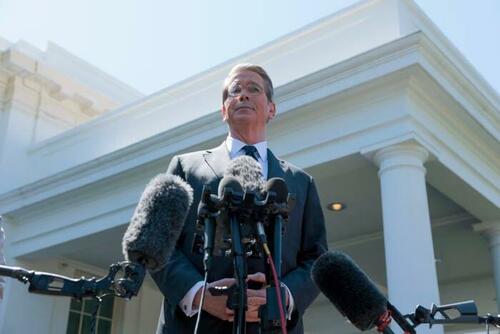
Великий Бессент Используйте тарифные переговоры, чтобы изолировать Китай от остального мира
Вчера президент Трамп в типичной лаконичной манере изложил ставки в постоянно обостряющейся торговой войне между США и Китаем: ""Мы хотим, чтобы страны выбирали между нами и Китаем." (тема обсуждается далее здесь), с Белым домом, добавив, чтоМяч находится на корте Китая. Китай должен заключить с нами сделку"
Эта стратегия принуждения мира к «Мы (или США) против нихЛагеря впервые появились на прошлой неделе, когда Трамп снизил взаимные тарифы для всех стран, кроме Китая.
Это на самом деле очень умный шаг: клубы всего мира против Китая. https://t.co/fsBagdFRRR
— zerohedge (@zerohedge) 9 апреля 2025 г.
Спустя несколько дней это стало официальной стратегией в мировой торговой войне.
Как сообщает WSJ, админ Трампа планирует использовать продолжающиеся тарифные переговоры, чтобы оказать давление на торговых партнеров США, чтобы ограничить их отношения с Китаем. По словам людей, знакомых с разговорами.
Идея, изложенная не во многих словах, состоит в том, чтобы • вырвать у торговых партнеров США обязательства по изоляции экономики Китая в обмен на снижение торговых и тарифных барьеров; Навязанный Белым домом. Американские официальные лица планируют использовать переговоры с более чем 70 странами, чтобы попросить их об этом. Китай не может отправлять товары через свои страны Так называемая «лазейка перевалки» не позволяет китайским фирмам размещаться на своих территориях, чтобы избежать тарифов США, и не поглощать дешевые промышленные товары Китая в свою экономику.
Эти меры предназначены для Окончательная доля в и без того слабеющей экономике Китая (который несколько иронично получил повышение в первом квартале, поскольку его экспортные партнеры закупали товары перед повышением тарифных цен, которое уже существует и которое поставит глубокую заморозку производственной империи Китая) и Заставить Пекин сесть за стол переговоров с меньшими рычагами в преддверии потенциальных переговоров между Трампом и президентом Си Цзиньпином. Точные требования могут широко варьироваться в зависимости от страны, учитывая степень их участия в китайской экономике.
Американские официальные лица уже представили эту идею на ранних переговорах с некоторыми странами, согласно источникам WSJ, которые добавили, что сам Трамп намекнул на стратегию во вторник, сказав испаноязычной программе «Fox Noticias», что он рассмотрит вопрос о том, чтобы заставить страны выбирать между США и Китаем в ответ на вопрос о решении Панамы не возобновлять свою роль в Инициативе «Пояс и путь», глобальной инфраструктурной программе Китая для развивающихся стран.
Трамп дарит ультиматум Латинской Америке
Выбор между США и Китаем
«Они должны это сделать»
Что должна сделать Латинская Америка? pic.twitter.com/MWVq2AJXJj
— RT (@RT_com) 15 апреля 2025 г.
Согласно WSJ, мозг, стоящий за стратегией Министр финансов Скотт Бессент, который взял на себя ведущую роль в торговых переговорах 9 апреля Трамп объявил о 90-дневной паузе на взаимные тарифы для большинства стран, но не для Китая.
Бессент предложил эту идею Трампу во время встречи 6 апреля в Мар-а-Лаго, президентском клубе во Флориде, сказали люди, знакомые с дискуссией. По его словам, получение уступок от торговых партнеров США может помешать Пекину и его компаниям избежать американских тарифов, экспортного контроля и других экономических мер.
Тактика является частью стратегии. По замыслу Бессента изолировать китайскую экономику, которая в последнее время набирает обороты среди чиновников Трампа. Дискуссии о масштабах и серьезности тарифов США продолжаются, но чиновники в значительной степени согласны с планом Бессента в отношении Китая.

Оно включает Отрезание Китая от экономики США тарифами и, возможно, даже сокращение китайских акций на американских биржах. Бессент не исключил, что администрация попытается исключить китайские акции из списка в недавнем интервью Fox Business. Тем не менее, конечная цель политики администрации в отношении Китая пока не ясна.
Бессент также сказал, что еще есть место для переговоров о потенциальной торговой сделке между США и Китаем. Такие переговоры должны были бы включать Трампа и Си. Пресс-секретарь Белого дома Каролина Ливитт зачитала новое заявление Трампа во время пресс-брифинга во вторник, в котором говорилось, что сделка с Китаем не является неизбежной.
Мяч находится на китайском корте. Ливитт сказал, когда читал заявление Трампа. «Китай должен заключить с нами сделку. Нам не нужно заключать с ними сделку. Китай хочет то, что у нас есть... американского потребителя. "
Действительно, как и все страны, которые Китай использует для взимания пошлин и/или перевалки, так что если Белый дом действительно расправится со всеми возможными портами въезда для американских потребителей, на долю которых приходится 70% примерно 30 триллионов долларов ВВП США, то у Китая не будет иного выбора, кроме как либо уступить, либо следовать двум другим подходам, которые мы изложили ранее: девальвировать валюту или развязать массивные фискальные стимулы.
У Китая есть три варианта:
1. Уступите поражение любым условиям, которые потребует Трамп
2. Девальвация юаня на 20-40%
3. Разверните самый большой финансовый стимул в своей истории (обсуждая $2-3 трлн), который вытолкнет его долг с графика.
— zerohedge (@zerohedge) 4 апреля 2025 г.
Также не ясно, вступила ли антикитайская линия в переговоры со всеми странами. Некоторые страны не слышали требований американских переговорщиков, связанных с Китаем, хотя переговоры остаются на ранних стадиях. Многие ожидают, что администрация Трампа рано или поздно поднимет связанные с Китаем требования.
Бессенс показал свое желание Антикитайские обещания торговых партнеров США. В конце февраля он сказал, что Мексика предложила соответствовать тарифам США на Китай в рамках переговоров по тарифам Трампа на Мексику, введенным из-за торговли фентанилом. Бессент назвал предложение Мексики «хорошим жестом», но эта идея не нашла большой поддержки у администрации.
С тех пор Бессент занял более центральную роль в торговых переговорах, взяв на себя ведущую роль в переговорах по взаимным тарифам после того, как 9 апреля Трамп объявил о своей 90-дневной паузе. Министр финансов планирует встретиться с министром экономического возрождения Японии. Он составил список стран, которые, по его мнению, могут вскоре заключить сделки с США, включая Японию, Великобританию, Австралию, Южную Корею и Индию.
Конечно, Китай не ждет, когда эта ловушка закроется, и проводит собственную торговую дипломатию. На этой неделе Си отправился во Вьетнам, ключевой торговый партнер США, сильно пострадавший от тарифов Трампа, и подписал десятки экономических обязательств с правительством Ханое, хотя в то же время Вьетнам намекнул, что он может сбалансировать свой торговый баланс с США, купив значительную военную технику у США.
Китайская точка зрения Обоюдный торговый гамбит Трампа как возможность, сказал Питер Харрелл, бывший старший директор по международной экономике в Совете национальной безопасности бывшего президента Джо Байдена, во вторник на панельной дискуссии в Законе Джорджтауна.
Но способность Китая противодействовать торговой политике США ограничена, сказал Харрелл. В то время как США остаются «масштабным нетто-импортером», Китай сокращает свой импорт из остального мира и фокусируется на самообеспечении. Проблема, как сказал Майкл Петтис, заключается в том, что Китай отстает на годы, если не на десятилетия, от своего собственного класса потребителей. Что пока оставляет только меркантилизм.
1/4
Поскольку единственный устойчивый способ сбалансировать китайскую экономику в сторону большей роли потребления в стимулировании спроса требует, чтобы доходы домашних хозяйств, включая трансферты, росли быстрее, чем ВВП, это хорошая новость. https://t.co/W9sv8XBx15
— Michael Pettis (@michaelxpettis) 16 апреля 2025 г.
И именно поэтому Пекин пытается нанести как можно больший финансовый ущерб США - вплоть до демпинга казначейских облигаций США в надежде на то, что доллар рухнет и вызовет нарративы о «конце статуса резерва доллара США», сохраняя при этом впечатление, что все хорошо внутри страны, как обсуждалось здесь.
Китай «не собирается заменять США в качестве источника спроса на продукцию, которую группа этих развивающихся стран... Сделай, - сказал Харрелл. «Таким образом, экономическая ситуация в этой области будет сложной для Китая, но я думаю, что мы видим, что они играют в эту политику достаточно мудро. "

Тайлер Дерден
Свадьба, 04/16/2025 - 13:05











![Powrót tradycji w Rzeszowie. Oficjalne ślubowanie Straży Miejskiej [ZDJĘCIA]](https://storage.googleapis.com/bieszczady/rzeszow24/articles/image/57ce861d-7991-4c1e-b85e-ab83a2abaff4)


